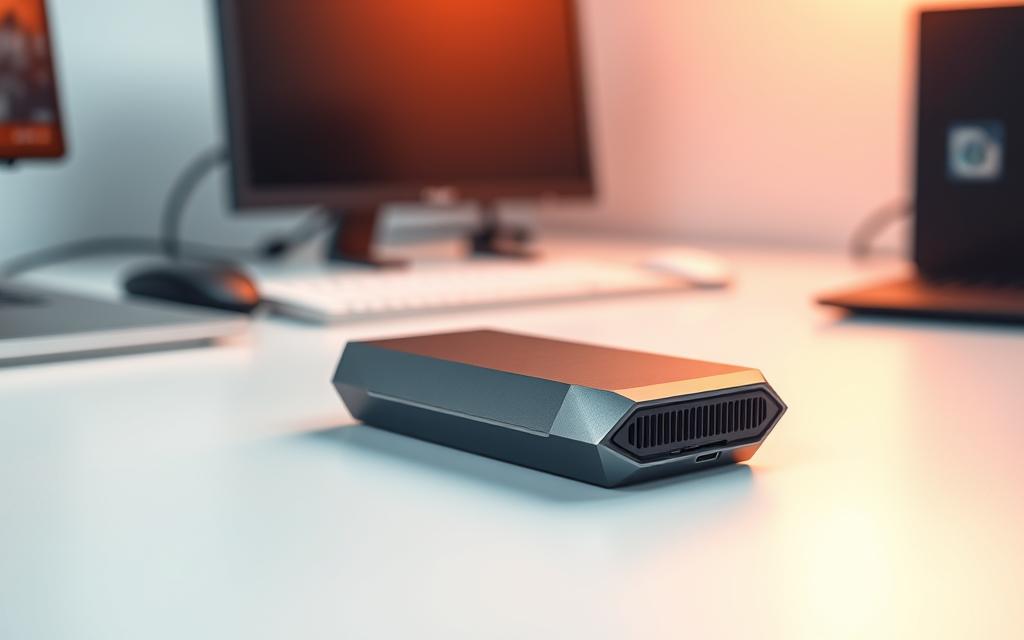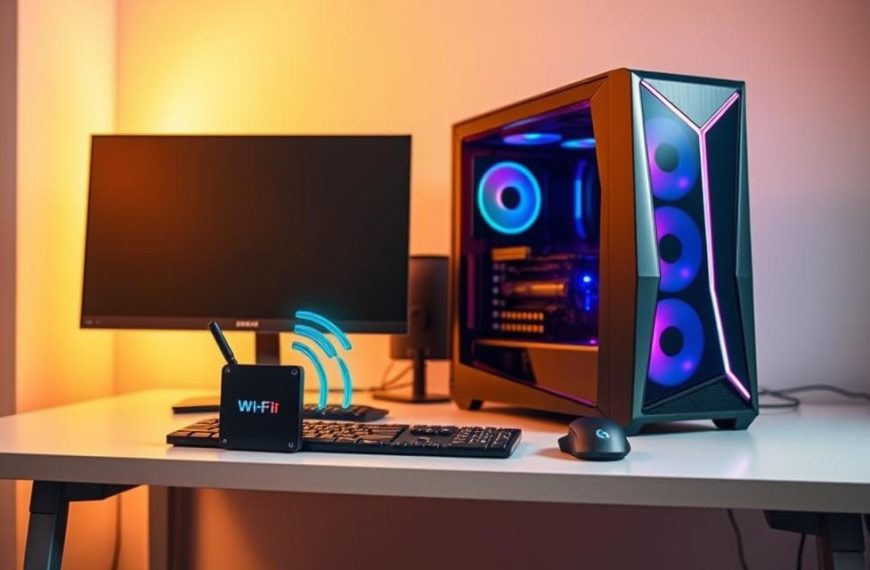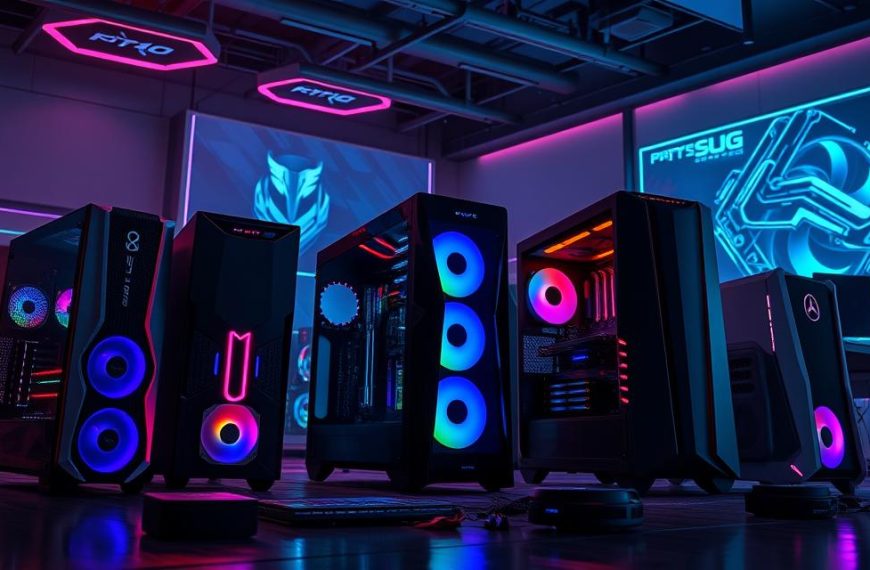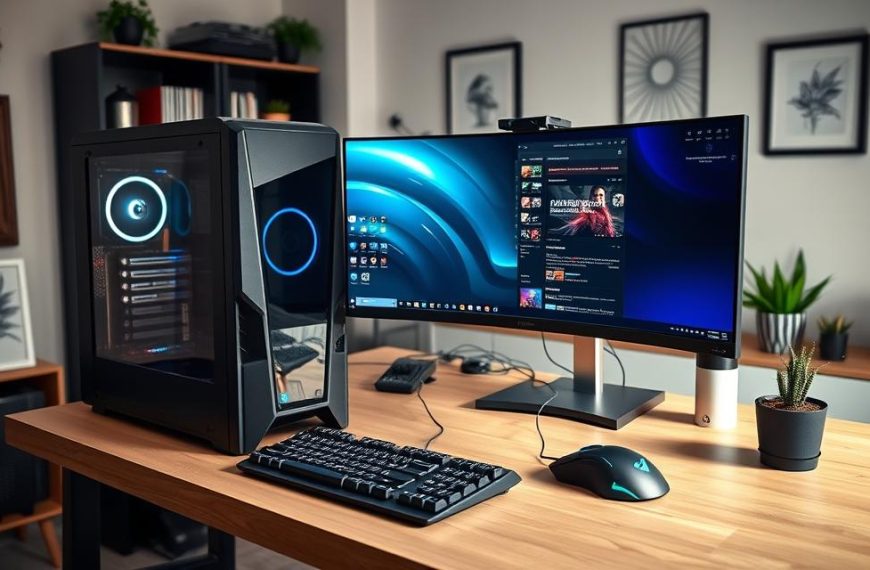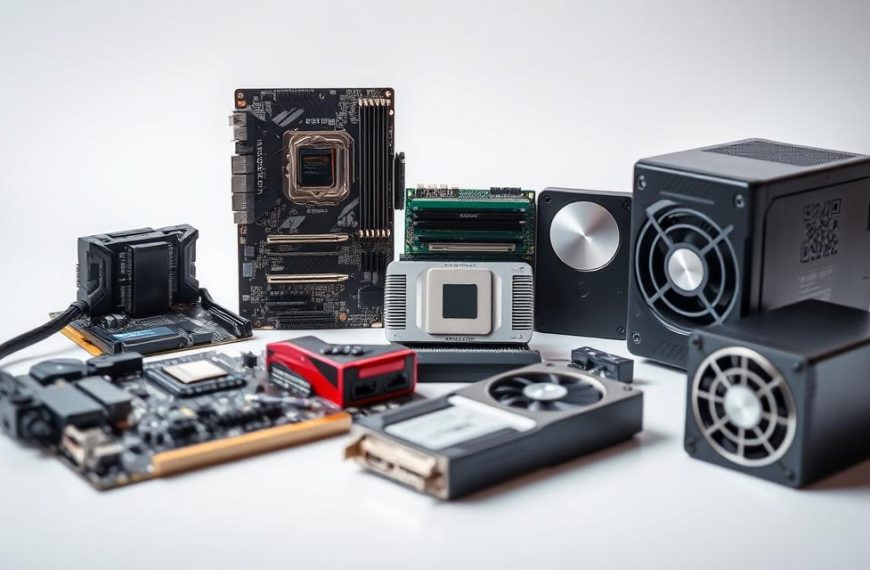Modern games demand high-speed storage solutions to deliver smooth performance. Traditional hard drives often struggle with the large file sizes and fast load times required by today’s titles. This is where solid-state drives (SSDs) shine, offering a significant upgrade in speed and efficiency.
External SSDs have become a popular choice for gamers seeking portable, high-performance storage. These drives reduce load times by up to 50% compared to HDDs, as highlighted by PCWorld testing. With read speeds exceeding 1000MB/s, devices like the Seagate FireCuda SSD ensure seamless gameplay and quick file transfers.
Portability is another key advantage. Compact and durable, external SSDs are ideal for gamers who need flexibility. Whether transferring large game files or playing directly from the drive, these devices eliminate bottlenecks caused by slower storage options. For more insights on choosing the right drive, check out this guide.
While external SSDs excel in performance, compatibility varies across platforms. For instance, the PlayStation 5 requires internal NVMe drives for PS5 games. However, many other consoles and PCs support external SSDs, making them a versatile solution for enhancing gaming experiences.
Introduction to External SSDs
External SSDs have revolutionized data storage with their compact design and lightning-fast speeds. Unlike traditional hard drives, these devices use NAND flash memory, which eliminates moving parts. This technology ensures faster access to data and improved durability.
One of the standout features of external SSDs is their physical resilience. They are shock-resistant, operate silently, and consume less power. These qualities make them ideal for on-the-go use, especially for professionals and mobile gamers.
The evolution of connectivity has also played a significant role. Early models relied on USB 3.0, but modern drives now support USB4 and Thunderbolt 4. These advancements provide faster transfer speeds and better compatibility with various devices.
For those who need extra durability, rugged models like the Lexar Armor 700 with IP66 ratings are available. These drives are protected against dust and water, making them perfect for harsh environments.
Modern external SSDs also feature TRIM support and wear-leveling. These technologies extend the lifespan of the drive by optimizing data storage and reducing wear on memory cells.
Form factors vary widely, from ultra-portable options like the Sabrent Nano V2 to larger, desktop-oriented drives. For DIY enthusiasts, enclosures like the Ugreen CM642 allow users to create custom NVMe solutions.
With their blend of speed, durability, and versatility, external SSDs are a must-have for anyone looking to upgrade their storage setup.
Can You Use an External SSD for PC Gaming?
Gaming enthusiasts often seek storage solutions that balance speed and portability. External SSDs have emerged as a popular choice, offering faster load times and smoother gameplay compared to traditional hard drives. These devices are compatible with a wide range of systems, making them versatile for both PC and console users.
Compatibility with Gaming Consoles
When it comes to gaming consoles, compatibility varies. The Xbox Series X supports external SSDs for backward-compatible titles, providing a seamless experience for older games. However, the PlayStation 5 requires internal NVMe drives for PS5-specific titles, limiting the use of external SSDs to PS4 games.
USB-C connectivity ensures broad compatibility across Windows, macOS, and Linux systems. This universal interface allows gamers to use the same drive across multiple platforms, enhancing flexibility. For cross-platform use, formatting the drive to exFAT is recommended.
Performance Expectations
Real-world benchmarks show that 20Gbps SSDs load AAA titles 30-40% faster than traditional hard drives. This significant improvement in speed reduces wait times and enhances the overall gaming experience. Thunderbolt 4 adoption in premium laptops further boosts performance, offering transfer speeds of up to 40Gbps.
Devices like the Adata SE920 EX leverage USB4 technology to achieve blazing-fast speeds, supported by active cooling for sustained performance. However, gamers should be aware of potential DRM and anti-cheat software compatibility issues when using external SSDs.
In summary, external SSDs deliver impressive performance and versatility, making them a valuable addition to any gaming setup. Whether for PC or console gaming, these drives offer a noticeable upgrade over traditional storage options.
Performance Benefits of External SSDs for Gaming
Performance upgrades in storage technology are transforming gaming. External drives deliver faster load times and smoother gameplay, enhancing the overall experience. These devices are designed to handle the demands of modern titles, ensuring seamless performance.
Faster Load Times
One of the most noticeable benefits is reduced load times. For example, Cyberpunk 2077 loads in just 12 seconds on an SSD compared to 35 seconds on an HDD. This improvement is critical for gamers who value efficiency and minimal downtime.
Devices like the Sabrent Rocket Nano V2 achieve read speeds of up to 1,800MB/s. Such performance ensures that large game files are accessed quickly, reducing wait times significantly. Faster load times also mean less frustration and more time spent playing.
Smoother Gameplay
External drives eliminate texture pop-in and stuttering, especially in open-world games. This is due to their ability to handle large data streams efficiently. Gamers can enjoy uninterrupted immersion without performance hiccups.
Latency improvements are another advantage. In competitive multiplayer titles, every millisecond counts. External drives reduce input lag, giving players a competitive edge. Additionally, the DirectStorage API on Windows 11 further enhances performance by optimizing data transfer.
Heat management is also a key factor. Devices like the Adata SE920 EX feature active cooling to maintain consistent write speeds during extended sessions. This ensures that performance remains stable even under heavy use.
External SSDs vs. Traditional Hard Drives for Gaming
When comparing storage options for gaming, the debate between SSDs and traditional hard drives often centers on speed, durability, and value. Each has its strengths, making them suitable for different needs. Understanding these differences helps gamers make informed decisions.
Speed and Responsiveness
SSDs outperform hard drives in speed and responsiveness. A 20Gbps SSD delivers four times faster sequential reads than a 5,400RPM hard drive. This translates to quicker load times and smoother gameplay, especially in AAA titles.
For example, Cyberpunk 2077 loads in 12 seconds on an SSD compared to 35 seconds on a hard drive. This speed advantage is critical for gamers who prioritize efficiency and minimal downtime.
Durability and Portability
SSDs are more durable due to their lack of moving parts. They can withstand shocks of up to 1500G, compared to 300G for hard drives. This makes them ideal for gamers who travel frequently or need rugged storage solutions.
Portability is another key factor. SSDs are often credit-card-sized, while hard drives are bulkier at 2.5 inches. This compact design makes SSDs easier to carry and use on the go.
Cost is a significant consideration. Hard drives offer better value for archival storage, with 8TB models costing $120 compared to $500 for a 4TB SSD. However, SSDs provide superior performance, making them worth the investment for active gaming.
Hybrid solutions are also gaining popularity. Gamers can use an SSD for active games and a hard drive for their library. This approach balances performance and cost-effectiveness.
Seagate’s Game Drive SSD for PS5 is a notable example. It combines PlayStation branding with the speed of an SSD, offering a tailored solution for console gamers.
In summary, SSDs excel in speed and durability, while hard drives remain viable for budget-conscious users or archival storage. Choosing the right option depends on individual needs and priorities.
Key Considerations When Choosing an External SSD for Gaming
Understanding the key factors in storage technology ensures optimal performance. When selecting a drive, focus on features that align with your gaming needs. This ensures a seamless experience with faster load times and smoother gameplay.
Storage Capacity
Modern game libraries require ample space. AAA titles often exceed 100GB, so a 1TB minimum is recommended. This allows for storing at least 10 games without frequent deletions. For larger libraries, consider 2TB or higher options.
Read/Write Speeds
Speed is critical for gaming. Drives with high read write speeds reduce load times significantly. For example, the Teamgroup M200 maintains consistent performance, though SLC caching can cause a 200MB/s drop in sustained writes. Always check benchmarks for real-world performance.
Interface and Connectivity
Connectivity impacts speed and compatibility. While USB 2.0 is outdated, USB 3.0 and USB4 offer 20Gbps and 40Gbps, respectively. USB 3.2×2 is a budget-friendly sweet spot, balancing price and performance. Ensure your hardware supports the chosen interface.
Durability and Build Quality
Durability is essential for portable drives. Look for devices with high TBW ratings, like the Crucial X10 Pro’s 1,200TBW. Rugged designs, such as the PNY RP60’s flat USB-C ribbon, offer added protection. For extreme speed seekers, RAID0 configurations are worth considering.
Top External SSDs for Gaming in [Current Year]
Choosing the right storage solution can elevate your gaming experience to new heights. With so many options available, it’s essential to focus on performance, durability, and value. Here are the best external drives for gaming today, each offering unique features to meet different needs.
Lexar SL600 Blaze – Best 20Gbps External SSD
The Lexar SL600 Blaze stands out with its 20Gbps transfer speeds, making it ideal for gamers who demand top-tier performance. Available in a 2TB capacity for $180, it features a lanyard-ready design for portability. The RGB SL660 variant adds a touch of style for those who want their setup to shine.
Teamgroup M200 – Best Budget 20Gbps Option
For gamers on a budget, the Teamgroup M200 offers excellent value. Priced at $90 for 1TB, it combines military styling with reliable performance. Future models promise up to 8TB, making it a scalable choice for expanding game libraries.
PNY RP60 – Best Rugged 20Gbps SSD
The PNY RP60 is built for durability, featuring an IP65 rating and water-resistant casing. At $100 for 1TB, it’s a great option for gamers who need a drive that can withstand harsh environments. Its rugged design ensures long-lasting performance.
Sabrent Rocket Nano V2 – Most Portable SSD
Weighing just 1.7oz, the Sabrent Rocket Nano V2 is the ultimate portable drive. Its silicone shock jacket provides extra protection, while capacities up to 4TB ensure ample storage for your games. This drive is perfect for gamers on the go.
Adata SE920 EX – Best USB 4 SSD
The Adata SE920 EX leverages USB4 technology to deliver 40Gbps throughput, making it one of the fastest drives available. Its slide-activated cooling fan ensures sustained performance during intense gaming sessions. This drive is a top pick for speed enthusiasts.
| Model | Warranty |
|---|---|
| Lexar SL600 Blaze | 5 years |
| Teamgroup M200 | 3 years |
| PNY RP60 | 3 years |
| Sabrent Rocket Nano V2 | 5 years |
| Adata SE920 EX | 5 years |
For niche needs, the Corsair Flash Survivor offers underwater durability, making it a unique option for extreme conditions. Whether you prioritize speed, portability, or ruggedness, these drives provide the best solutions for gaming today.
How to Set Up an External SSD for Gaming
Setting up an external drive for gaming requires attention to detail to maximize performance. Proper formatting, partitioning, and transferring games ensure seamless gameplay and faster load times. This guide walks through the essential steps to optimize your setup.
Formatting and Partitioning
Before using the drive, formatting is crucial. For Windows, the Disk Management tool is a reliable option. Third-party tools like EaseUS Partition Master offer advanced features for customization. Choose NTFS for Windows-only setups or exFAT for cross-platform compatibility.
Optimizing the allocation unit size improves performance. A 64KB size is recommended for game installations, as it balances speed and efficiency. This ensures large files are handled smoothly.
Transferring Games to the SSD
Moving games to the external drive is straightforward. Steam’s Library migration tool simplifies the transfer process. For Epic Games, manually relocate the game folder and update the launcher settings. Always back up data before large transfers to avoid data loss.
Wired connections are faster than docked setups. Thunderbolt docks offer up to 40Gbps, ideal for quick transfers. USB 3.2×2 is a budget-friendly option, providing 20Gbps speeds. For example, transferring 100GB of data at 20Gbps takes approximately 8 minutes.
| Connection Type | Speed | Transfer Time (100GB) |
|---|---|---|
| USB 3.2×2 | 20Gbps | ~8 minutes |
| Thunderbolt 4 | 40Gbps | ~4 minutes |
Troubleshooting common issues ensures smooth operation. USB power delivery limitations can cause disconnections. Use a powered hub or ensure the cable supports adequate power. Proper setup guarantees a hassle-free gaming experience.
Common Myths About External SSDs for Gaming
Many gamers hesitate to adopt external SSDs due to persistent myths about their capabilities. These misconceptions often stem from outdated information or comparisons to older technologies. Let’s debunk some of the most common myths and explore the real benefits of using these drives for gaming.
Myth: External SSDs Are Too Slow for Gaming
One of the most widespread myths is that external drives lack the speed needed for modern gaming. In reality, 20Gbps SSDs achieve 90% of internal SATA SSD performance, as confirmed by Digital Foundry tests. These drives significantly reduce load times, with some titles loading up to 40% faster than on traditional hard drives.
Benchmarks show that PCIe 3.0 x4 interfaces deliver low latency, making external SSDs viable for even the most demanding games. For example, Unreal Engine 5 titles benefit from improved VRAM streaming, ensuring smoother gameplay and fewer stutters.
“External SSDs are no longer a compromise; they’re a legitimate upgrade for gamers seeking faster load times and better performance.”
Myth: SSDs Don’t Improve Game Performance
Another misconception is that SSDs only affect load times and not in-game performance. However, tests in GPU-bound scenarios reveal that SSDs enhance frame rate stability and reduce texture pop-in. This is especially noticeable in open-world games, where large data streams are common.
Endurance is also a concern for some gamers. A 1TB SSD can handle 500GB of daily writes for over five years, making it a durable choice for long-term use. Additionally, budget-friendly options like the Western Digital Blue offer excellent value at around $50 per terabyte.
| Drive Type | Load Time (Cyberpunk 2077) | Frame Rate Stability |
|---|---|---|
| External SSD (20Gbps) | 12 seconds | 98% |
| Internal NVMe | 10 seconds | 99% |
| Traditional HDD | 35 seconds | 85% |
In summary, external SSDs are a powerful tool for enhancing gaming experiences. They debunk the myths of being too slow or ineffective, offering speed, durability, and improved performance for gamers at every level.
Future of External SSDs in Gaming
The evolution of storage technology is reshaping how gamers experience their favorite titles. With advancements in connectivity and capacity, external drives are becoming more powerful and versatile. These innovations promise faster transfers, larger libraries, and enhanced performance for gamers today and in the future.
USB4 and Thunderbolt Advancements
USB4 2.0 is set to revolutionize storage with speeds up to 80Gbps. This technology supports asymmetric bandwidth, enabling seamless 120Hz 8K displays. Thunderbolt advancements also play a key role, offering 40Gbps throughput for lightning-fast transfers.
Microsoft’s DirectStorage 1.2 introduces GPU decompression, reducing load times further. PCIe 5.0 enclosures with active cooling ensure sustained performance during intense gaming sessions. These innovations make external drives a viable way to enhance gaming setups.
Increasing Storage Capacities
QLC drives are entering the consumer market with capacities up to 8TB. PLC NAND technology promises even greater potential, with portable drives reaching 100TB+. This expansion allows gamers to store entire libraries without compromise.
By 2026, 4TB SSDs are predicted to cost under $100, thanks to 3D NAND scaling. Hybrid cloud models with local SSD caching are also emerging, offering a balance between speed and accessibility. These trends ensure that best external drives remain a top choice for gamers.
| Technology | Feature | Impact |
|---|---|---|
| USB4 2.0 | 80Gbps speeds | Faster transfers |
| PLC NAND | 100TB+ capacity | Larger libraries |
| DirectStorage 1.2 | GPU decompression | Reduced load times |
Emerging security features, like hardware encryption standards, add an extra layer of protection. These advancements ensure that external drives remain a reliable and efficient way to store and access games. The future of gaming storage is bright, with innovations that cater to every gamer’s needs.
Conclusion
Storage technology continues to redefine gaming experiences, offering faster speeds and greater flexibility. With load times reduced by up to 50%, these devices ensure smoother gameplay and quicker access to large files. Durability and portability make them ideal for gamers on the go.
For value, USB 3.2×2 drives with 2TB capacity are a top choice. They balance speed and affordability, making them a practical investment. Increasing console support for external storage solutions further enhances their versatility.
Pairing a high-speed ssd with an archival HDD is a smart strategy for large libraries. This combination maximizes performance while keeping costs manageable. Tested models like the Lexar SL600 for speed and the Teamgroup M200 for budget needs are highly recommended.
Before purchasing, ensure compatibility with your motherboard or console interface. Emerging technologies like U.2 external enclosures promise even greater advancements, keeping these drives relevant for years to come. Upgrade your setup today and elevate your gaming experience.

